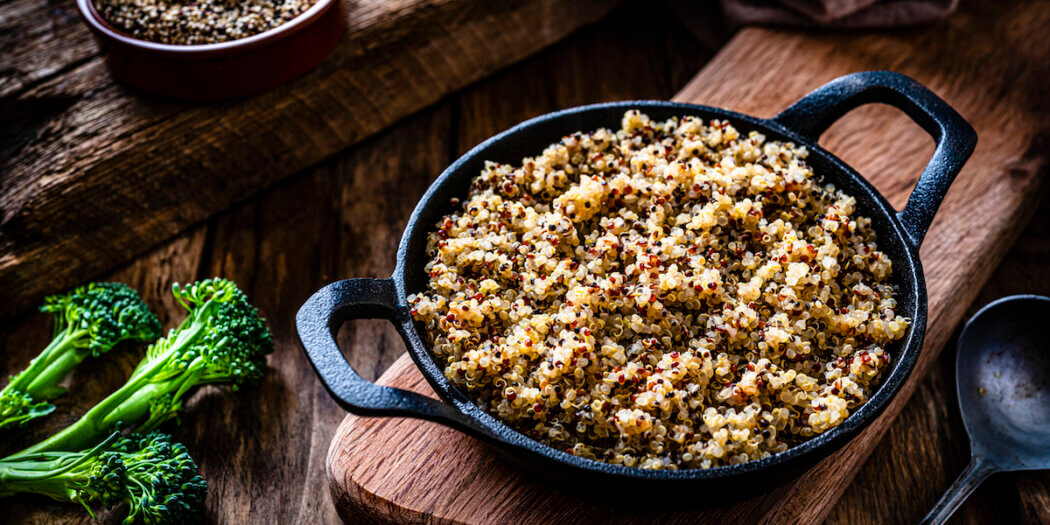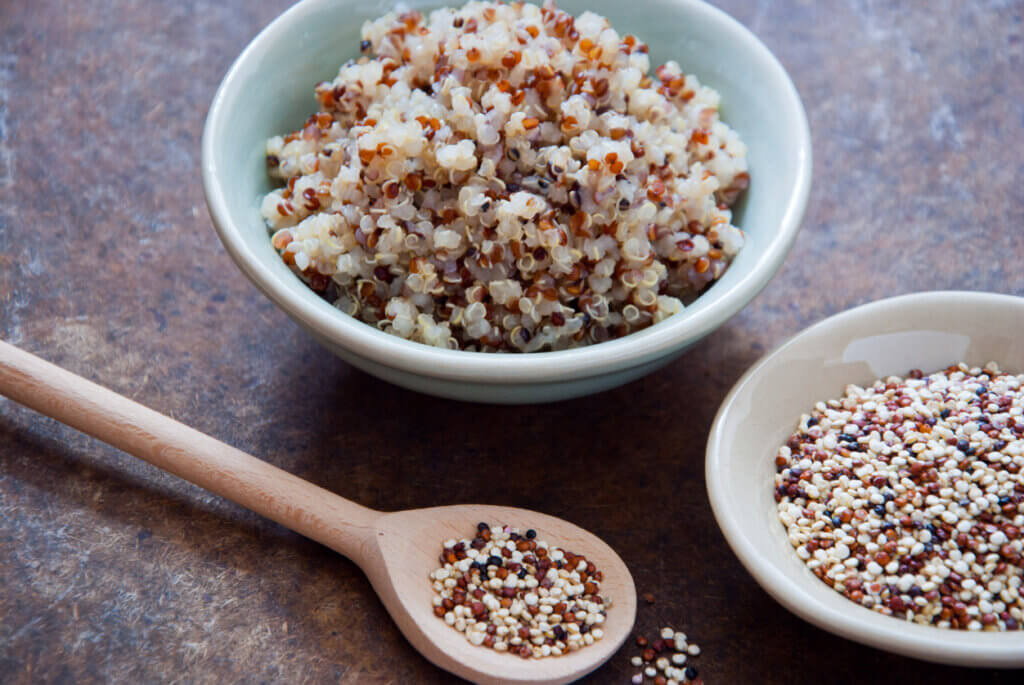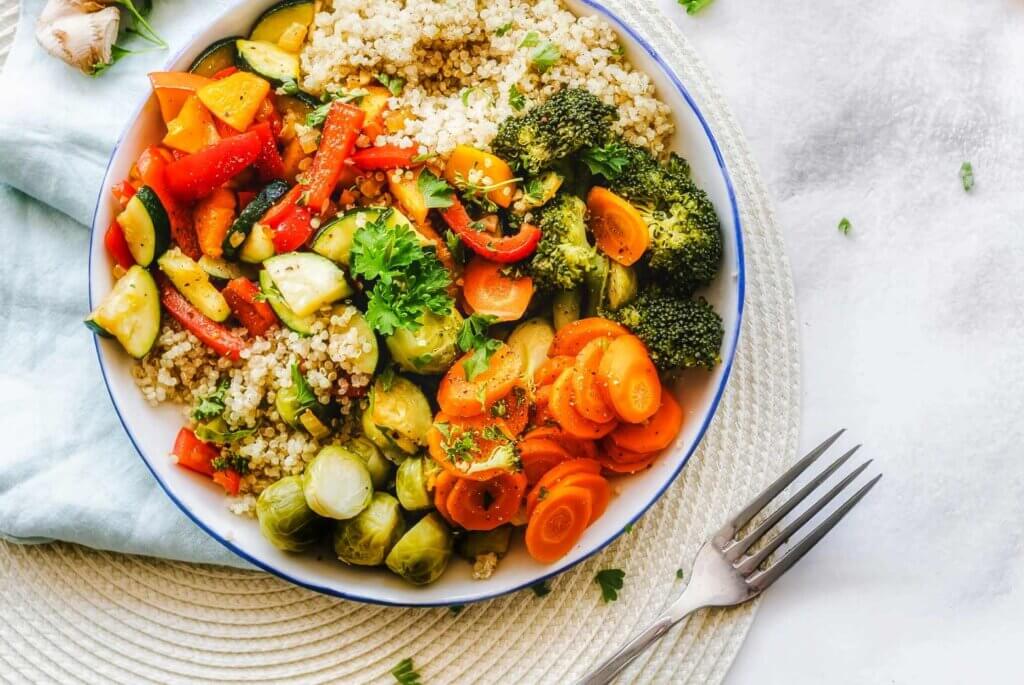Grocery Guides
Quinoa: Origin, Nutritional Facts, and More!

Quick Answer
What is quinoa?
According to some sources, quinoa is one of the healthiest foods in the world. Pronounced KEEN-wah, it’s often called a pseudo-grain because it has many nutrients, and some people eat it the same way they eat cereal.
While quinoa isn’t (botanically speaking) a grain, people love it because it’s packed with nutrients, it’s gluten-free, and it’s got plenty of health benefits.
Most people don’t know that there are over 3,000 types of quinoa, but the most widely grown types are red, white, and black. There’s also a type that’s a mixture of the three colors.
Quinoa can be rolled into flakes, ground into flour, and used for baking and cooking.
Where did quinoa originate from?
Quinoa was first grown in the Andes about 7,000 years ago. Even though it’s grown all around the world, it’s mainly produced in Peru and Bolivia. It originated in the Incas (supposedly in the mountains of Bolivia, Peru, and Chile). In fact, it’s still a staple food in the indigenous descendants’ diet. Sometimes called the mother of grains, quinoa comes with a bit of a backstory. The legend goes that the Incan emperor planted the first quinoa seeds every year in a ceremonious fashion.

What is the nutritional value of quinoa?
Quinoa is often called a superfood because it offers more nutritional benefits than your average food (or grain).
Quinoa not only contains beneficial plant compounds, but it contains complete proteins.
In just 1c (185g) of quinoa, you’ll get:
- 58% of your daily value (DV) of manganese
- 30% of your DV of magnesium
- 28% of your DV of phosphorus
- 19% of your DV of folate
- 15% of your DV of iron
- 13% of your DV of zinc
That cup will also get you 8g of protein and 5g of fiber with only 4g of fat. If you want to increase your intake of essential vitamins, fiber, and minerals, consuming more quinoa can help you do it.
How is quinoa grown?
Quinoa does best in cool climates with plenty of light. Moist conditions help the plant thrive. Quinoa plants are pretty easy to grow and don’t require much maintenance.
You’ll need fertilizer, water, and well-drained, loamy soil with a high organic matter concentration to grow quinoa. Before you start planting, amend the soil with fertilizer or compost. Mulch the seedlings once they’re a few inches tall to help them retain moisture and prevent weeds.
Water your quinoa plants regularly but be careful not to waterlog them. If you’re growing from seed, make sure the last frost has passed before you sow the seeds in the garden because seedlings that are too delicate won’t be able to hold up in the frost.

What is the shelf life of quinoa?
Usually, quinoa will last until the “best by” date on the packaging, typically 2-3 years from the date it was produced (which might also be on the packaging).
However, quinoa may be able to last as long as a year after that date before it’ll spoil, but that’s only if it’s stored well. And make sure not to leave quinoa out for more than a few hours after you cook it. Put it in the fridge once you’re done eating.
How do you pick quinoa at the grocery store?
When shopping for quinoa at the grocery store, look for a boxed variety of a popular brand or try a brand that looks good to you for a specific reason (their harvesting practices, packaging, organic, etc.).
If you’re looking to have your groceries delivered, you can easily shop for quinoa via Instacart. After adding a product to your cart, use the “Instructions” option to notify your Instacart shopper about any preferences or specific directions on how to choose the best products. Shop for quinoa.

How to store quinoa
Store quinoa in the fridge (after cooking it) for up to a week. Make sure it’s in an airtight container — that’ll prevent it from getting contaminated or absorbing the flavors of other foods (which can make it taste pretty bad).
You can also store quinoa in the freezer, which can keep it safe to eat for up to a year. However, keep in mind that the longer you leave it in the freezer, the more flavor it’s likely going to lose.
How to tell if quinoa is bad
Quinoa can and will go bad if you don’t store it properly. Storing it in the pantry can be a good idea, as long as you regularly check it to make sure nothing has gotten into it (like bugs and insects).
You’ll be able to tell it’s bad if it has a nasty smell (because dry grains don’t usually have a smell). You might be able to tell just by looking at it. If you notice it start to darken from its original yellow color, it might be bad.
Also, note that there won’t always be signs of spoilage, so you won’t know unless you cook it. If you cook it and it doesn’t soften up, then you might have bad quinoa.
When it comes to cooked quinoa, you’ll notice similar signs — changes in color and a nasty odor are signs it’s time to chuck your quinoa.
What can I substitute for quinoa?
Ran out of quinoa? Don’t stress. You can substitute it with any of the following:
- Brown rice
- Chickpeas
- Barley
- Red beans
- Couscous
- Cauliflower
- Broccoli
- Nuts
- Roasted veggies
- Legumes
Warming up to the idea of quinoa? Get some delivered
Now that you know about all the benefits of quinoa, you’re probably anxious to get your hands on some. But you don’t have to run out to the store or waste time searching for “quinoa near me.” Get a bag of quinoa delivered with Instacart and choose same-day delivery!
Most Recent in Grocery Guides

Grocery Guides
19 Best Milk Substitutes for Baking and Cooking
Milk’s rich texture and neutral flavor make it a staple in countless recipes, bringing creaminess and balance to sweet and savory dishes alike. But what happens if you run out of milk or need a…
Jan 30, 2025
Grocery Guides
15 Best Cheeses for Your Next Charcuterie Board
Let’s face it: The heyday of the store-bought party platter is long gone. Now, the duties of a good host often include curating an impressive charcuterie board. But where do you begin? Charcuterie boards typically…
Jan 21, 2025
Grocery Guides
Guide to Movie Night Snack Delivery
Planning the perfect movie night means getting cozy, choosing a favorite film and gathering all the right treats. With movie night snack delivery, you can skip the hassle of a grocery run and have delicious…
Dec 19, 2024

 Squash – All You Need to Know | Instacart Guide to Fresh Produce
Squash – All You Need to Know | Instacart Guide to Fresh Produce  Ghost Pepper – All You Need to Know | Instacart Guide to Fresh Produce
Ghost Pepper – All You Need to Know | Instacart Guide to Fresh Produce  Sprouts – All You Need to Know | Instacart Guide to Fresh Produce
Sprouts – All You Need to Know | Instacart Guide to Fresh Produce 

